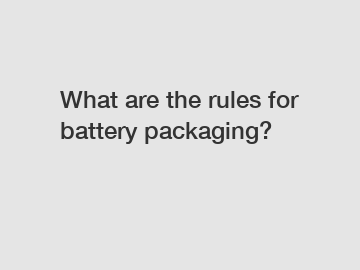What are the rules for battery packaging?
When it comes to packaging batteries, there are strict rules and regulations that must be followed to ensure the safety of both the product and the consumer. Batteries, especially lithium-ion batteries, can be dangerous if not properly handled and packaged. In this blog post, we will discuss the rules for battery packaging and why it is so important to adhere to them.
First and foremost, it is crucial to understand the potential dangers associated with batteries, particularly lithium-ion batteries. These batteries have the potential to overheat and catch fire if they are damaged or punctured. Improper packaging can lead to these dangers becoming a reality, putting both the people handling the batteries and the end consumer at risk.
One of the most important rules for battery packaging is that batteries must be packaged in a way that prevents them from being damaged during transportation. This includes using sturdy packaging materials that will protect the batteries from impact and ensuring that there is enough padding to absorb any shocks that may occur during transit. Additionally, batteries must be securely fastened in their packaging to prevent them from moving around and potentially causing damage to themselves or other items in the package.

Another rule for battery packaging is that batteries must be clearly labeled with information about the type of battery, its voltage, and any other relevant information. This is important for both the people handling the batteries and for consumers who may be purchasing the product. Clear labeling helps to ensure that the batteries are handled properly and that consumers are aware of what they are purchasing.
In addition to proper packaging and labeling, there are also rules regarding the transportation of batteries. Batteries must be packaged in a way that complies with regulations set forth by organizations such as the International Air Transport Association (IATA) and the Department of Transportation (DOT). These regulations dictate how batteries should be packaged for air or ground transportation to ensure the safety of the shipment.
It is also important to note that certain types of batteries, such as lithium-ion batteries, may be subject to additional regulations due to their potential to overheat and catch fire. These regulations may include restrictions on the quantity of batteries that can be shipped together, as well as requirements for how the batteries should be packaged to prevent short circuits or other hazards.
Overall, the rules for battery packaging are in place to protect both the people handling the batteries and the end consumer. By following these rules and regulations, manufacturers can help to ensure that their products are transported safely and that consumers can use them without fear of injury or damage.
In conclusion, batteries are a crucial component of many electronic devices, but they can also be dangerous if not handled and packaged correctly. The rules for battery packaging are in place to protect both the product and the consumer, and it is important for manufacturers to adhere to these rules to ensure the safety of everyone involved. By following proper packaging and labeling guidelines, as well as complying with transportation regulations, manufacturers can help to prevent accidents and ensure that their products reach consumers safely and intact.
Are you interested in learning more about cylindrical lithium battery battery pack assembly, cylindrical lithium battery assembly equipment, cylindrical lithium battery pack assembly line? Contact us today to secure an expert consultation!


